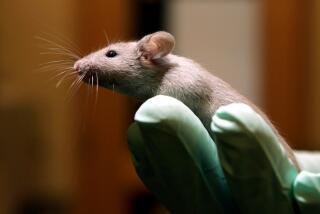Medical Treatment Gains Seen in Manipulating Cells
- Share via
STANFORD — A biologist who changed seven types of human cells into muscle says the research could help scientists understand how cells develop and could lead to better treatments for cancer and muscular dystrophy.
Dr. Helen Blau and her colleagues at Stanford University reported that they manipulated the signals that control the genetic material of cells and convincingly showed that cell development can be altered.
Human liver, lung, cartilage and amniotic fluid cells and three types of skin cells were converted into muscle by fusing them with muscle cells of mice and reprogramming their DNA, Blau said.
A high percentage of the hybrid cells became activated, producing proteins found only in specialized muscle cells to control contractions, she said.
“It was thought for a long time that cell development was controlled by a series of changes in gene structure that were irreversible,” Blau said. “It’s not irreversible. The genes responsible are surprising susceptible to manipulation.”
Earlier Hybrids Unstable
Other researchers have fused cells, but the resulting hybrid cells have been unstable, short-lived and difficult to study, Blau said.
“They got different results and thought certain cells couldn’t be reprogrammed,” she said. “One of the most successful parts of our research has been producing stable cells with their nuclei intact. They could be studied over a two-week period and we could compare different cell types.”
The researchers are trying to isolate the regulators of the muscle genes and study their interaction.
The work, supported by the National Institutes of Health, the Muscular Dystrophy Assn. of America, the March of Dimes and the National Science Foundation, was reported in Science Magazine’s special “Frontiers in Biology” issue.
Cells Differentiate
All the millions of cells in the body, which develop from a single, fertilized egg, contain the same genetic information in their DNA. Yet, as cells differentiate into specialized organs, they use different portions of their genetic code.
Scientists understand little about how cells activate or suppress different sets of genes and develop into cells with specific functions.
“I think this technique affords us a unique opportunity to isolate regulators of gene expression, to learn how they interact with specific genes, and to determine how they control the time sequence of differentiation,” she said.
Blau, who earned her doctorate at Harvard University, has worked on her project for seven years. She emphasized the basic nature of her research but said understanding cell differentiation is important in cancer research, genetic engineering and the future of gene therapy to treat diseases.
‘Handle on Malignancy’
“If one understands normal differentiation, one can get a handle on abnormal differentiation such as malignancy,” she said.
In the genetic engineering industry, where it is important to create large quantities of particular products, it is important to understand the regulation of genes, she said.
“In gene therapy, the idea is to try to replace a gene in a tissue where it’s aberrant or absent,” she continued. “In order to do that properly, you have to know how the gene is regulated.”
The research may help in the battle against muscular dystrophy, she said, because the disease is “clearly developmental, sometimes before birth, sometimes afterward.
“In muscles, as in other cells, like blood, genes are expressed at different times,” she said, and the process affects the development of the muscular system.






